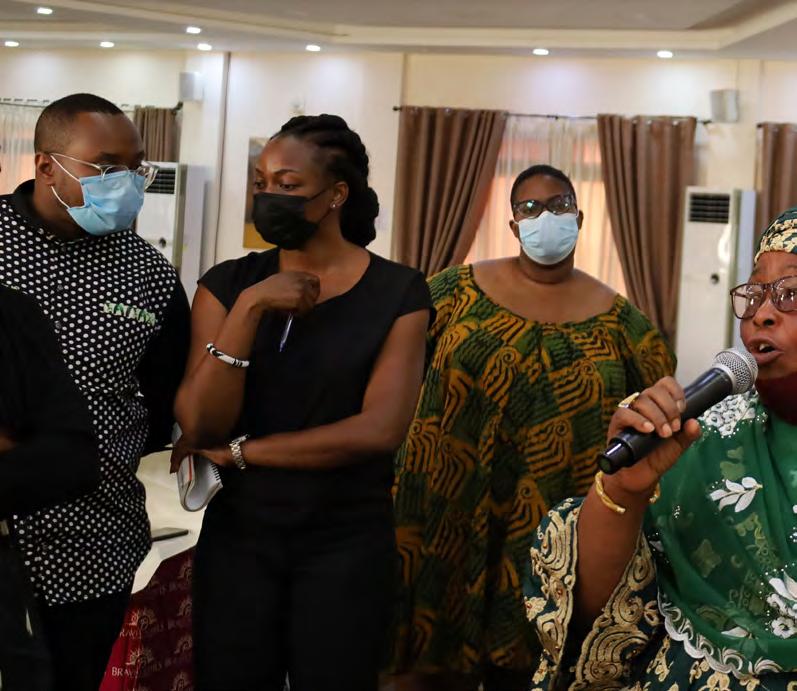
4 minute read
CONVERSATION WITH OUR REGIONAL AGMP MEMBERS
As an activist-led fund, we place equitable representation of the LGBTQ
community in the decision-making processes of the Fund as central to ensuring responsiveness, transparency, and accountability. This means that the majority decisions are made by activists through an autonomous participatory body called the Activist Grant Making Panel (AGMP). The AGMP is made up of 13 members who are activists from the different LGBTQI communities in West Africa. Members are recruited to reflect diverse institutional, social, and political experiences within the West African LGBTQI movement.
Advertisement
We asked two members of our regional Activist Grant Making Panel (AGMP) to share with us their learnings from being part of our participatory grantmaking process. Members of our AGMP remain anonymous.

1. Why is participatory grantmaking important for local activists and groups?

Participatory grantmaking is important for local activists and groups because it allows us to directly address the priorities for our communities. It avoids imposing on groups what actions and issues to work on and/ or engage in, and it brings out the real needs of these groups without imposing anything on them. This process also engages the activists themselves and contributes to their capacity building. It balances the sharing of resources and addresses issues that are often not funded by donors while also engaging young associations and identities that are often overlooked. It allows the activists involved in the assessments to have a voice for all the local groups, which makes it possible to take into account different themes and bring the different realities and needs of the communities to the table.

2. What challenges have you experienced as members of the participatory grantmaking committee?
One of the difficulties encountered was the integration at the AGMP level because of the different origins, languages, experiences and backgrounds of the activists. We had to find our way and adapt. Also, at the level of evaluations, despite the priorities of the region, it was necessary to take into account the country contexts in order not to prejudice certain requests because some countries are more advanced than others in terms of commitment and actions. After reading the proposals it is often difficult for us to make choices to meet the real needs of the targets. Apart from that, there are no major difficulties.
3. What lessons have you learned as a member of the participatory grantmaking committee?
As activists, we are not careful enough and are negligent in the grant applications we send out which can be detrimental to us very often and we will complain that we don’t get funding when we have good ideas to help our communities but in writing the applications, we don’t bother to follow the guidelines.
If the majority of donors allow groups and activists to decide what actions to take according to their needs and priorities, there will be more efficiency and the situation will improve in our different countries.

4. Would you say participatory grantmaking is effective?
I think it is effective because the strategies and actions that are funded are innovative, in line with the region’s priorities and rarely receive funding. Effectiveness is measured by results and the feedback we get confirms this. This strategy has allowed us to address issues that are not typically addressed in grant applications with other funders, to address issues that are extremely important but are often not funded, and to diversify the identities of grantees. Today, when we see the young organizations that receive funding and the LBQ groups that manage to carry out certain actions thanks to ISDAO’s funding, we are proud of them and we believe in the effectiveness of the strategy used by ISDAO, the provision of participatory grants.

5. How do participatory approaches support diversity, inclusion and/or equity?
Participatory approaches support diversity, inclusion, and equity in that they allow for representation of all identities in terms of decision-makers, evaluators, and consideration of all identities in resource sharing and action. They balance resources at the level of the LGBTQI community so that no identity is left behind.
All projects are treated with equal attention and rigour. No one project is sacrificed to the detriment of another. The work is done in such a way that all components are included. The AGMP respects this because all of its members are of diverse sexual orientations and gender identities.

6. Do you think more funders should engage in participatory grantmaking? If yes, why?
Yes, funders should think about this and engage in participatory grantmaking. We know our priorities and the strategies that can work in our contexts. Donors should think about involving activists if they really want to make a difference and achieve change. They should stop imposing on us specific action plans and areas to work on, as the LGBTQI situation evolves from one context to another. We want to leverage strategies that work in other regions, but not have priorities imposed on us.
We need more funders to engage in this process because it gives activists the opportunity to learn about the movement. It also allows them to define their own priorities and needs in their different contexts. This way they feel involved.










